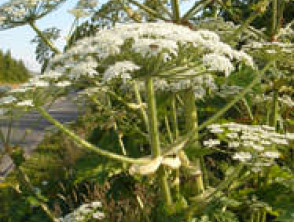| Common name: | Giant hogweed |
| Botanical name: | Heracleum mantegazzianum Sommier et Levier |
| Family: | Giant hogweed belongs to the Apiaceae family (or Umbelliferae), which has over 2500 species in 275 genera. These include common herbs such as cow parsnip (sometimes called hogweed) anise, carrot, celery, coriander, dill, fennel, parsley, and parsnip, as well as the highly toxic hemlocks. |
| Origin: | Native to Asia, more specifically the western Caucasus but it is now widespread in Europe and North America. In the USA this species escaped from cultivation and has become a public health hazard, being found in urban, suburban and rural settings. Giant hogweed is usually found in sunny, moist and disturbed habitats. It is a serious weed that invades areas likely to have high use by people, such as river and stream banks, roadsides and right-of-ways. |
| Description: | It is a giant perennial herb that varies in height from 2.0 to 5.0 m, which may live for several years. It has a large and dark reddish-purple stem (c. 10 cm in diameter), and spotted leaf stalks, both of which are hollow. The compound leaves of H. mantegazzianum may expand to over a meter in breadth, with each leaflet being deeply incised. The inflorescences are composed of many small white florets and arranged in large umbels that can grow to 1.0 m in diameter. |
| Uses: | It is a popular plant in gardens due to its attractiveness. |
| Allergens: | The sap of H. mantegazzianum contains psoralens (furocoumarins) that lead to phytophotodermatitis, which is produced by the interaction of such plant compounds with sunlight on human skin. The psoralens are lipid-soluble and penetrate into the epidermis with ease. The photochemical excitation of psoralens is induced by ultraviolet radiation, usually within the UVA wavelengths of 320-400 nm. Note that the absorption of psoralens into the skin (and the consequent reaction) is enhanced by high humidity. Two types of toxic reactions occur: one oxygen-independent where the ultraviolet-activated psoralens bind to RNA and nuclear DNA, and an oxygen-dependent reaction where the induced compounds cause cell membrane damage and oedema. These reactions consequently lead to cell death. |
| Allergy: | Phytophotodermatitis is a phototoxic reaction, and not an allergic one so there is no immunological response. As a result, no prior sensitization is necessary and anybody can be affected. Heracleum mantegazzianum is one of the main causes of phytophotodermatitis in the UK and USA. |
| Other information: | Giant hogweed is on the USA federal noxious weed list, which means that its importation into the country is illegal, as is the interstate and intrastate movement of this species. In New Zealand H. mantegazzianum is listed in the National Plant Pest Accord, and it is an unwanted organism under the Biosecurity Act 1993, pursuant to section 2(1). This prevents its legal sale, propagation or distribution within New Zealand. Extreme care should be exercised when removing these plants, and it must be stressed that contact with dead plant parts and with inanimate objects or pets that have been in contact with such plants is dangerous. The use of protective water-resistant clothing and protective goggles is therefore advisable when dealing with H. mantegazzianum, as is the simultaneous avoidance of exposure to sunlight. |
